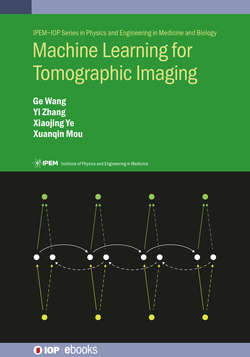Читать книгу Machine Learning for Tomographic Imaging - Professor Ge Wang - Страница 28
На сайте Литреса книга снята с продажи.
2.2 Single-layer neural network
ОглавлениеIn this section, we will introduce two typical dictionary learning algorithms both of which are single-layer neural networks. Although these algorithms are theoretically equivalent to the sparsity constraint method (Olshausen and Field 1996) and ICA method (Bell and Sejnowski 1997) as we introduced in the previous chapter, the algorithms introduced in this chapter are more data-driven and have been widely used in practice.
Previously, we introduced Bayesian reasoning, in which the prior information of images is of great importance and must be analytically expressed. Thus, it is an essential task to find an efficient measure to express different information contents. This points to the field of image representation and sensory coding. The HVS tends to ignore the first-order and second-order features when sensing structures in natural scenes. Since the HVS has an efficient strategy for conveying as much information as possible, features used by the HVS should be statistically independent of each other. Researchers suggested a number of de-correlating strategies to remove statistical redundancy from natural images and represent the original information by a dictionary consisting of over-complete atoms.
Sparse dictionary learning is a representation method aiming at finding a sparse representation of an input signal or image as a linear combination of basic building units. One of the most important applications of sparse dictionary learning is in the field of compressed sensing or signal recovery. In the context of compressed sensing, a high-dimensional input signal can be recovered with only a few dictionary components provided that the signal is sparse. A sparse representation of that input signal is an important assumption since not all signals satisfy the sparsity condition. One of the key principles behind dictionary learning is that the dictionary must be generated from data. In other words, the dictionary is not constructed according to a principle or principles in advance. The dictionary learning methods are developed to represent an input signal with a minimized number of dictionary components and at maximized representation accuracy.
Let a dictionary be denoted as D∈Rn×K, each column of D denoted as dk is a component of the dictionary and also referred to as an atom of the dictionary. Without loss of generality, the dictionary D has K atoms and each atom consists of n elements. A signal or image (after vectorization) y∈Rn×1 can be represented sparsely as a linear combination of atoms in the dictionary D, which is formulated as y=Dα, or approximated as y≈Dα, and ∥y−Dα∥p⩽ε for some small value ε and a certain Lp-norm. In order to seek a sparse solution, a variety of regularization schemes were proposed, which reflect prior information of coding coefficients α∈RK×1, into the optimization problem, such as the L0-norm constraint
minx∥α∥0s.t.y=Dα(2.4)
or
minx∥α∥0s.t.∥y−Dα∥2⩽ε,(2.5)
where ∥a∥0 denotes the total number of nonzero entries in the vector α. The use of the L0-norm as a measure of sparsity makes the problem nonconvex and, as mentioned earlier, solving the equation directly is an NP-hard problem (Elad 2010). The choice of these atoms is crucial for efficient sparse representation, but it is not trivial. Therefore, it is informative to study what kind of dictionary expression or visual coding is accurate and efficient.
Different from the dictionary learning and sparse representation methods presented in chapter 1, in the following sections we will introduce more efficient methods to complete the tasks. In general, the methodology of dictionary learning and sparse representation contains two tasks. The first is to learn an over-complete dictionary D in equations (2.4) and (2.5) from a set of data which captures plenty of essential structures, i.e. the atoms of the dictionary such that any single datum can be sparsely or independently represented by a few numbers of the structures of the dictionary. The second is sparse coding which means finding, for a specific signal, the representation vector α regarding the dictionary D to meet the sparse constraint. Let us first learn a classical sparse coding method, i.e. the matching pursuit algorithm (Mallat and Zhang 1993), given that the dictionary D is provided.
